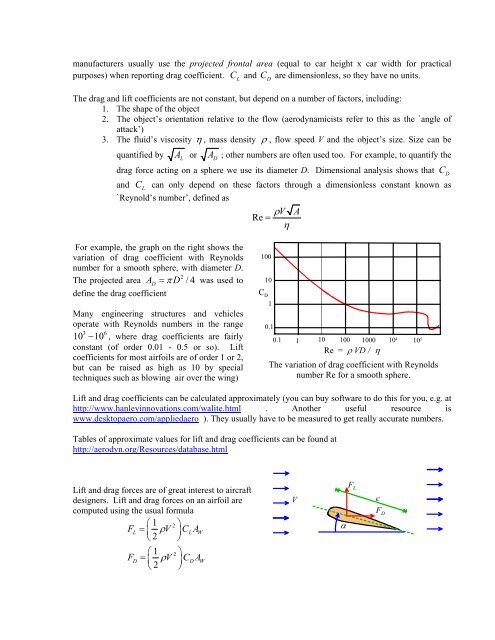Chapter 2 Review of Forces and Moments - Brown University
Chapter 2 Review of Forces and Moments - Brown University
Chapter 2 Review of Forces and Moments - Brown University
Create successful ePaper yourself
Turn your PDF publications into a flip-book with our unique Google optimized e-Paper software.
manufacturers usually use the projected frontal area (equal to car height x car width for practical<br />
purposes) when reporting drag coefficient. C <strong>and</strong> C are dimensionless, so they have no units.<br />
L<br />
The drag <strong>and</strong> lift coefficients are not constant, but depend on a number <strong>of</strong> factors, including:<br />
1. The shape <strong>of</strong> the object<br />
2. The object’s orientation relative to the flow (aerodynamicists refer to this as the `angle <strong>of</strong><br />
attack’)<br />
3. The fluid’s viscosity η , mass density ρ , flow speed V <strong>and</strong> the object’s size. Size can be<br />
quantified by A<br />
L<br />
or A<br />
D<br />
; other numbers are <strong>of</strong>ten used too. For example, to quantify the<br />
drag force acting on a sphere we use its diameter D. Dimensional analysis shows that C<br />
D<br />
<strong>and</strong> C<br />
L<br />
can only depend on these factors through a dimensionless constant known as<br />
`Reynold’s number’, defined as<br />
ρV A<br />
Re =<br />
η<br />
D<br />
For example, the graph on the right shows the<br />
variation <strong>of</strong> drag coefficient with Reynolds<br />
number for a smooth sphere, with diameter D.<br />
The projected area A<br />
2 D<br />
= π D /4 was used to<br />
define the drag coefficient<br />
Many engineering structures <strong>and</strong> vehicles<br />
operate with Reynolds numbers in the range<br />
3 6<br />
10 − 10 , where drag coefficients are fairly<br />
constant (<strong>of</strong> order 0.01 - 0.5 or so). Lift<br />
coefficients for most airfoils are <strong>of</strong> order 1 or 2,<br />
but can be raised as high as 10 by special<br />
techniques such as blowing air over the wing)<br />
100<br />
10<br />
C D<br />
1<br />
0.1<br />
0.1 1 10 100 1000 10 4 10 5<br />
Re = ρ VD / η<br />
The variation <strong>of</strong> drag coefficient with Reynolds<br />
number Re for a smooth sphere.<br />
Lift <strong>and</strong> drag coefficients can be calculated approximately (you can buy s<strong>of</strong>tware to do this for you, e.g. at<br />
http://www.hanleyinnovations.com/walite.html . Another useful resource is<br />
www.desktopaero.com/appliedaero ). They usually have to be measured to get really accurate numbers.<br />
Tables <strong>of</strong> approximate values for lift <strong>and</strong> drag coefficients can be found at<br />
http://aerodyn.org/Resources/database.html<br />
Lift <strong>and</strong> drag forces are <strong>of</strong> great interest to aircraft<br />
designers. Lift <strong>and</strong> drag forces on an airfoil are<br />
computed using the usual formula<br />
⎛1<br />
2 ⎞<br />
FL = ⎜ ρV ⎟ CLAW<br />
⎝2<br />
⎠<br />
⎛1<br />
2 ⎞<br />
FD = ⎜ ρV ⎟ CDAW<br />
⎝2<br />
⎠<br />
V<br />
α<br />
F L<br />
c<br />
F D
















